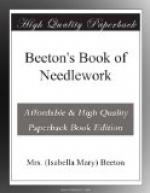ILLUSTRATIONS 76 & 77.—Raised satin stitch is principally used for blossoms, flowers, leaves, letters, &c. After having traced the outlines of the pattern, fill the space left between them with chain stitches in a direction different from that in which the pattern is to be embroidered; begin at the point of the leaf, working from right to left, make short straight stitches, always
[Illustration: 76.—Raised Satin Stitch.]
inserting the needle close above the outline and drawing it out below. The leaves on the flowers, as well as on the branches, must be begun from the point, because they thus acquire a better shape. If you wish to work a leaf divided in the middle, as seen in illustration 77, you must trace the veining before you fill it with chain stitches, then begin at one point of the leaf and work first one half and then the other.
[Illustration: 77.—Raised Satin Stitch.]
[Illustration: 78.—Point de Plume.]
ILLUSTRATION 78 shows the so-called point de plume on a scalloped leaf. It is worked like the satin stitch, only the needle is drawn through the material in a slanting direction.
[Illustration: 79.—Point de Minute.]
ILLUSTRATION 79 (Point de Minute).—This stitch is often used instead of satin stitch when the patterns must appear raised. Wind the cotton several times round the point of the needle, which is inserted into the material half its length (the number of times the cotton is to be wound round the needle depends on the length of the pattern), hold fast the windings with the thumb of the left hand, draw the needle and the cotton through the windings, insert the needle into the material at the same place, and draw it out at the place where the next stitch is to begin.
[Illustration: 80.—Ladder Stitch.]
[Illustration: 81.—Ladder Stitch.]
ILLUSTRATIONS 80 & 81 show the ladder stitch, often used in ornamental embroidery. Trace first the outlines as seen in illustrations; mark also the cross stitches between the outlines, so that the first touch the outlines only at both ends. The outlines are embroidered in overcast stitch or double overcast; the material is cut away underneath the ladder stitch between the outlines.
We have now shown the different kinds of stitches used in embroidery; the following illustrations show them used for different patterns.
[Illustration: 82.—Button-hole Stitch Scallop.]
[Illustration: 83.—Button-hole Stitch Scallop.]
[Illustration: 84.—Button-hole Stitch Scallop.]
[Illustration: 85.—Button-hole Stitch Scallop.]
ILLUSTRATIONS 82 TO 85 (Different Button-hole Stitch Scallops).—These scallops are prepared as above described. Take care to have the stitches even and regular; the scallops must be wide in the centre and very fine at both ends.




